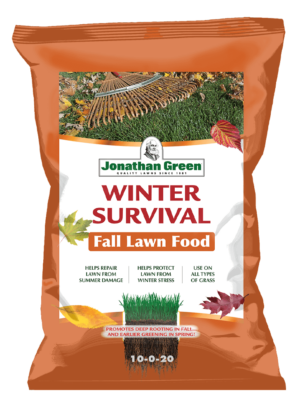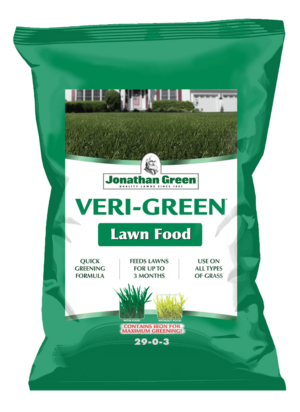Do you dream of having the kind of lawn that turns heads and makes the rest of the neighborhood green with envy? If so, you're in the right place! Whether you're a seasoned lawn care expert or just starting your journey, we are here to make your green space a success. As an industry leader, Jonathan Green offers a wide range of top-grade lawn care products designed to meet the specific requirements of your yard.
At Jonathan Green, we understand that a lush, healthy lawn is more than just a source of pride. Not only does it enhance the natural beauty of your property, it also boosts its overall curb appeal. A green yard becomes a sanctuary for relaxation, a place where you can unwind and enjoy time with your family and friends. However, achieving and maintaining such a lawn is no small feat. Often you're faced with challenges like stubborn weeds, persistent pests, and the threat of diseases.
But fret not! The key to conquering these challenges lies in choosing the right lawn care products and treatments. With our extensive expertise and commitment to quality, we've become the go-to, professional brand for grass aficionados like yourself. When it comes to nurturing and revitalizing your lawn, we've got you covered.
Our reputation speaks for itself. With countless satisfied customers, we've earned our stripes as a trusted name throughout the lawn care industry. What sets us apart is our dedication to providing high-quality products that deliver exceptional results. From grass seed and fertilizers to weed control and insecticides, our broad range of lawn and grass care products is expertly crafted to address your unique needs.
In the following sections, we'll explore the different types of lawn care products offered by Jonathan Green and when to use them. So, let's roll up our sleeves, grab your spreader, and learn the secrets of a flourishing lawn.
The Right Grass for Your Lawn
Starting with the right grass seed is key to growing a strong, healthy lawn. Whether you're planting new grass, overseeding, or filling in bare patches, you should choose a grass seed that is ideal for your area and climate.
Cool-season grasses like tall fescue, Kentucky bluegrass, and perennial ryegrass thrive in northern regions, while warm-season options such as Bermudagrass and zoysia are ideal for southern climates.
Jonathan Green specializes in cool-season grass seed mixtures that grow exceptionally well in a variety of climate conditions, such as sunny, heavily-trafficked, or shady lawns. If you want grass that can grow roots up to 4 ft. deep, has a waxy, protective coating to protect your lawn from the elements, and can withstand periods of drought, Black Beauty grass seed is a perfect choice.
To explore the full Black Beauty line and get started growing your dream lawn, buy grass seed online here!
Nurture Your Soil for Stronger Grass
Healthy grass starts with healthy soil! Loose, well-balanced soil provides the foundation for strong roots and vibrant growth. Testing your soil’s pH and adding the right amendments can improve nutrient absorption and prevent compaction.
Products like Mag-I-Cal Plus and Love Your Soil that balance soil pH and relieve soil compaction are essential additions to any healthy lawn care plan! We also provide easy-to-use soil pH test kits to help you make sure your soil stays within a healthy range.
To begin caring for your yard from the foundation up, check out our collection of soil amendments for lawns!
Fertilize for a Greener, Healthier Lawn
To maintain a lush, green lawn, fertilization is essential. A well-fed lawn grows thicker, resists disease, and withstands drought. Fertilizers supply important nutrients like nitrogen, phosphorus, and potassium for stronger root development and vibrant color.
For cool-season grasses, feeding three times a year—in early spring, late spring, and fall—helps sustain growth and protect against seasonal stress.
Jonathan Green offers lawn fertilizers tailored for every stage, whether you’re establishing new grass or preparing for winter.
To feed your lawn and explore our full range of products, visit our Lawn Fertilizer page!
Prevent & Control Weeds
Weeds can quickly take over if left unchecked. While hand-pulling works in the early stages, larger weed populations require targeted lawn weed control to prevent damage and restore your lawn’s beauty.
Most weed controls offer either pre-emergent control of weed seeds before they germinate or post-emergent control of weeds above the surface to kill them and prevent them from coming back. Jonathan Green offers premium lawn weed controls to treat and prevent a wide variety of lawn weeds. Our 2-in-1 weed controls offer the convenience of having fertilizer and weed control in one product, which helps you save both time and money.
To browse all of our options, visit our weed preventers collection!
Protect Against Lawn Insects & Fungus
Lawn pests and fungal diseases can wreak havoc on an otherwise healthy lawn. Grubs, chinch bugs, and other insects damage grass by feeding on roots and blades, while fungal infections thrive in humid conditions, leading to brown patches and thinning turf.
If you're dealing with insect or fungus problems in your yard, let Jonathan Green be your solution! Visit our lawn insect and disease control page to explore our full range of products.
Go Green with Natural Lawn Care
Switching to eco-friendly lawn care helps protect the environment while keeping your lawn lush and safe for kids and pets. Natural products use plant-based ingredients like corn gluten and essential oils to nourish grass without synthetic chemicals.
Jonathan Green’s natural solutions offer a sustainable way to grow a vibrant lawn while reducing chemical exposure. To explore all of our eco-friendly products, visit our Natural Lawn Care page!
Tools & Accessories for Easy Application
A well-maintained lawn starts with the right tools. Lawn spreaders ensure even application of seed, fertilizer, and soil amendments, while accessories like pH testers and patch kits help fine-tune your lawn care routine.
Spreaders are classified as either handheld spreaders for smaller projects, such as seeding bare spots, or drop and rotary spreaders for larger projects, such as planting a new lawn.
Lawn accessories, such as lawn patcher products, grass seed mats, soil pH test kits, and ice melters, are the cherry on top, as they are convenient add-ons to any lawn care routine!
If you want to use a quality spreader to seed your lawn, test your soil, quickly reseed a bare spot, or even patch up your lawn, Jonathan Green has the right product for you!
Visit our Lawn Spreader page and our Lawn Tools & Accessories page to explore our full range of products!
Lawn Care Bundles for Complete Care
Simplify your lawn care routine with all-in-one product bundles! Whether you need to balance soil pH, fertilize, seed, or control weeds, our carefully curated systems make it easy to get the right products from start to finish. Check out all of our lawn care kits to start taking care of your specific needs today!
 Lawn Fertilizers
Lawn Fertilizers Grass Seed
Grass Seed Lawn Care Bundles
Lawn Care Bundles Soil Amendments
Soil Amendments Lawn Fertilizers
Lawn Fertilizers Lawn Fertilizers
Lawn Fertilizers Grass Seed
Grass Seed Grass Seed
Grass Seed Lawn Care Bundles
Lawn Care Bundles Lawn Care Weed Control
Lawn Care Weed Control Grass Seed
Grass Seed Soil Amendments
Soil Amendments Grass Seed
Grass Seed Grass Seed
Grass Seed Soil Amendments
Soil Amendments Lawn Care Weed Control
Lawn Care Weed Control Grass Seed
Grass Seed











